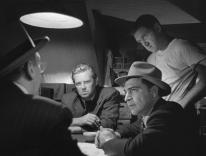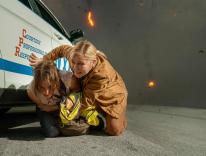Ryan Fleck’s downbeat school drama, Half Nelson, is the kind of indie effort that is truly a creation of the film festival. Fleck first did the film as a bargain-basement short, then, after winning Sundance’s 2004 Grand Jury Prize in short filmmaking, he got some funding together and took a second, feature-length whack at the same materia. He returned to Sundance this year and won Best Film.
Over the decades, the myth of a teacher toiling in a harsh urban environment has spawned such classics as Blackboard Jungle, To Sir with Love, and Stand and Deliver. The story line is so familiar it is burned into our collective unconscious: new teacher survives harrowing rites of initiation, then dishes out inspiration, challenge, and heart, transforming a ragtag crew of reprobates into a corps of proud achievers-salvaging kids society had no faith in, and winning their eternal gratitude.
In recent years, boredom with the old formula, or perhaps simply our jaded and ironic zeitgeist, has wrought havoc with this formula; iconoclastic films such as Election or Blue Car portray the teacher as tempted, sinning, or merely bored to death, slogging through an eternally changeless routine (that montage in Election where we see Matthew Broderick delivering the same civics lecture in a dozen different shirts). In Half Nelson, Fleck and his co-writer Anna Boden take this demythologizing to the extreme. Their protagonist, a young and ostensibly idealistic white man named Dan Dunne, teaches history at an inner-city school populated primarily by black and Latino children. Bedraggled and irreverent, Dunne adopts a stance of siding with the students against “the machine”; when his supervisor checks up on him teaching a class, he’s chewing gum, and she has to take it away.
But Dunne, it turns out, uses illicit substances far worse than gum. Early in the movie, we see him coaching the girls’ basketball team; after the game, he ducks into the school lavatory, whips out a vial and a pipe, and lights up a rock of crack cocaine. One wonders if even the most addled user might not at least make it out to his car; but in the act, Dunne is discovered-zoned-out in a bathroom stall-by one of his students, thirteen-year-old Drey (Shareeka Epps). A thoughtful African-American girl, Drey has problems of her own-an absent father; an older brother in jail for dealing drugs; an EMT mother working double shifts to keep it all together; and a lurking dealer who employed her brother as a courier and wants to use her as well.
One heartbreaking reality of Half Nelson is that Drey is not particularly shocked to see her favorite teacher strung out on crack; addiction is too routine in her world. What she feels is a mix of anger, curiosity, and the urge to help. The rest of the movie charts her complicated back and forth with Dunne, and her progress toward the scary uncertainties of her own future. Will life snatch the Tootsie-Pop that’s perpetually in Drey’s mouth, symbol of childhood innocence, and replace it with a rock of crack? How can she hope to avoid that, when even her teacher is an addict?
At every turn, Fleck and Boden thwart the heartwarming redemptive story line we have in our minds. Real life doesn’t work that way, the film insists; and every time we expect Dunne to pull himself together, he caves in yet again. But the attempt at gritty realism backfires. The moral chaos presented in Half Nelson lacks depth and pathos. In a way, the film suffers from being too faithful to its material. From the get-go, Dunne is mired in a desperate drug habit, and while the depiction of addiction’s remorseless pathology may be believable, it isn’t interesting, except in a clinical way. The movie comes off like one of those “This is your brain on drugs” commercials, delivering shock after shock. Dunne is a moral calamity. Well, of course he is; he’s a drug addict. “He’s a basehead,” the drug dealer comments when Drey insists that Dunne is her friend, “and baseheads don’t have friends.”
They don’t have much complexity, either, and Ryan Gosling, the handsome young actor who plays Dunne, struggles against severe limitations in the script. A lot seems implicit in his face, but the film never brings it to the surface, and after a certain point, Dunne’s fey, jittery, smiling poses become highly annoying. “Coach,” Drey asks him at one point; “what’s it like to smoke that stuff?” Dunne’s refusal to answer seems a failure on the part of Boden and Fleck. There’s so much more they could give us. What about Dunne’s earlier life? What was he like at twenty? How did he get where he is? When he’s high and cruising bars, chatting up women, he starts ranting about history and teaching; such scenes hint at a core of idealism and intellectual interest, but Half Nelson tells us next to nothing about what happened to it.
The New York Times critic, Manohla Dargis, praised Half Nelson effusively, citing in particular “its sense of everyday texture” and “its insistence on political consciousness as a moral imperative.” It’s hard to see what this consciousness consists in, beyond Dunne rambling on to his class about the dialectical nature of history, and giving his students a timeline of topics-the Attica prison riot, Brown v. Board of Education, the overthrow of Salvador Allende-which we then see in newsreel highlights as his students earnestly narrate. Fleck even includes footage of Mario Savio, leader of the Free Speech Movement, delivering a fiery address at Berkeley; this is history conceived as the greatest hits of the Nation or the Progressive. Doggedly, Half Nelson stays at that level. It’s political, yes, but rather in the way of a lurid Victorian melodrama, touring us through the brutalization of the junkie underclass. For character it substitutes pathology; instead of an arc of drama, we get a relentless slide to the bottom.
Manohla Dargis is a fairly new critic at the New York Times, and I suppose I thought I knew her better. I took her recommendation to see not only Half Nelson but another indie film, Old Joy, by Kelly Reichardt, which Dargis praised as “one of the finest American films of the year,” a “universal...story about memory and loss.”
For a reviewer, that is going pretty far out on a limb. Not more than twenty minutes into this aimless and shallow film, I was hearing the sound of not only the limb, but the whole tree, the whole forest, crashing down. Old Joy purports to offer a spiritual glimpse into two thirty-something guys, old college friends who go off on a trek in the woods outside Portland, Oregon, searching for a natural hot spring said to be in the area, and for their lapsed friendship. While the merits of Half Nelson are at least debatable, Old Joy struck me as a failure through and through. Desultory and badly underwritten, it commits the cardinal sin of saddling us with a protagonist we find boring and obnoxious-a guy in his thirties who has never outgrown the stoner pseudo-profundity of a college freshman. This is eighty-three minutes about two guys who go to the woods and take a bath. Arguably, the character with most depth is their dog: there’s a moment when he decides whether to cross a plank laid across a roaring brook, and his hesitation evokes more drama than anything else in Old Joy, and a better performance as well. One of the finest American films of the year? I guess Dargis and I can agree on one thing-the film is a sleeper.
Please email comments to [email protected] and join the conversation on our Facebook page.
Previous Story
TV Land
Next Story
Grumpy Good Samaritan


